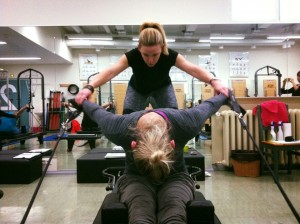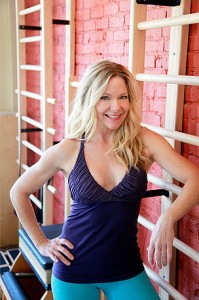Perspective – A Beginning
by Amy Havens
I have one. You have one. Mine is different than yours. I quite like that we each have our own, but sometimes I’d like to share yours and I think, from what I can tell, you’d like to share mine. Am I right? This is “OK” isn’t it, to share, to agree, to align? I am inspired by yours and, at the same time, I value mine tremendously; it is mine after all. It can change though and I think it’s important to allow this ebb and flow, because without allowing this freedom – this shift, a change of stance from time to time – things can get stuck, tense, wedged. No, I’m not talking about posture, fascia, muscles or a physical movement pattern per se. It is something universal however that each one of us has.
I’m in the field of movement education, striving to teach and heal people through movement. I use Pilates to help people stay strong, flexible, easy in their bodies and minds, to prevent injuries, to recover from them, to learn and discover new skills when I spend time with them. I endeavor to teach efficiency and economy of movement, so a person can go about their life with spontaneous zest and vigor. I encourage self-reflection, introspection, and the use of mind and spirit to connect with their physical self to inspire people to get to know, understand and love what their bodies, minds and spirits can do, together. What is it that you do? How do you spend your days? Although we have this ‘thing’ that’s similar, our differences are imperative in keeping the texture of this world rich and varied. Just like snowflakes or fingerprints, no two are exactly alike. Are you wondering yet what I’m getting at, what this conversation is all about? I’m talking about perspective.
Perspective:
“a particular attitude toward or way of regarding something; a point of view.”

Recently, I was given an assignment to create a lineage tree (akin to a family tree) that included anyone and everyone that influenced my life as a movement teacher. “OK,” I thought, “that shouldn’t be too hard to do.” When I sat down to begin my homework assignment, I was amazed at how many people showed up from pen to paper! My hand kept going and going, starting at age 6 and making its way through that very day the assignment was given to me. I listed, as best I could, the many, many people who have influenced me, who have inspired me, who have allowed me the space to become the teacher I am today. Looking over this list, I was reminded of their faces, their voices, and their opinions on the things that meant so much to me – movement and education. Not everyone on this list shared the same perspective but they fundamentally agreed that movement mattered, that movement was healthy, and that movement education was time well spent and energy wisely expended.
It’s all movement, and there is no bad movement, or as Eve Gentry said – “”there is no bad movement, only movement done badly’. But in my professional community of Pilates, a divided conversation still exists – “classical” or “contemporary.” This topic comes up often and, although some have very strict opinions on which style is ‘best’ or ‘true’ or ‘right’, I yearn for a balance between the points of view. If we can agree that movement heals and that movement is healthy and can help us achieve physical and mental fitness, why can’t we agree that one perspective on Pilates isn’t necessarily any better or worse than another?

Perspective is a point of view. You have yours, I have mine – thankfully, we each have our own. No one perspective is the only point of view, of seeing any object. No one opinion is the only opinion. No one has your eyes to see what you’re seeing even when looking at the same object. Pilates looks different to me now than it did when I first began my lessons with Gary Calderone and Jeff Woodman all those years ago, but at the end of the day, it’s still Pilates.
The world is ever-changing as are our bodies and minds. This should encourage us to honor the changes that continue to occur in our profession, the developments and adaptations in equipment and program design, the inventions that keep surfacing to challenge our capacity for physical strength and our understanding of biomechanics. I think we have shared values that Pilates is a superior modality that is not going anywhere and that everyone should practice it. I also challenge us to take a good long look at those things within our profession that are similar, that share the same perspective or point of view, that bring us together – and honor, nurture and respect them. It’s all movement … and movement heals.
None of us would be here without the shared point of view that the Pilates method is an incredible lifelong endeavor. Now, I will add this very strong opinion – that although Pilates continues to grow and change, it is the responsibility of all teachers coming into this profession to learn the origins of Pilates. I urge all new teachers of this work to read Joe Pilates’ original material, to view film of the original work, to see the exercises and locations as they were in the beginning. In other words, to “nerd out” on the heritage of the Pilates method. How else can we form our own opinions as to how we want to be seen in this profession, how we want to develop our individual perspective, our point of view, if we don’t know where we came from and who influenced us to teach this method? If we can agree on the power of Pilates and its benefits, maybe we can agree to widen our perspective, to look at Pilates from several points of view and to nurture the ever-developing timeline to which we can all contribute.
I want to be a name on someone’s lineage tree …

Amy holds a B.A. in Dance from Colorado State University. She was first introduced to the Pilates Method by way of her modern dance teachers and soon met Gary Calderone and Jeff Woodman, both graduates of The Pilates Center of Boulder, CO. Immediately becoming fascinated with the beauty, grace, strength, and logic of this method, she knew becoming a Pilates teacher was in her future. She recognized this was a mental and physical practice and a lifelong discipline. Amy moved to the San Francisco bay area to pursue a performing career and like many dancers, sustained an injury. Pilates and chiropractic were her means of rehabilitation and it was the transition out of the dance world that enabled Amy to follow her intuition to deepen her relationship with the Pilates Method. She completed her Comprehensive Teacher Training Program through The PhysicalMind Institute® taught by Madeline Black and Jean Sullivan and as an apprentice, was asked to teach at A Body of Work in San Francisco. Amy is the owner of CenterPoint Pilates Inc, a premier studio in Santa Barbara, CA. You can see more about Amy here.

